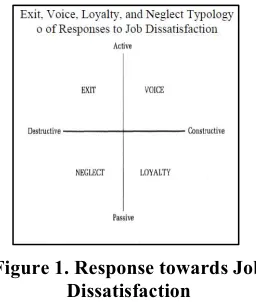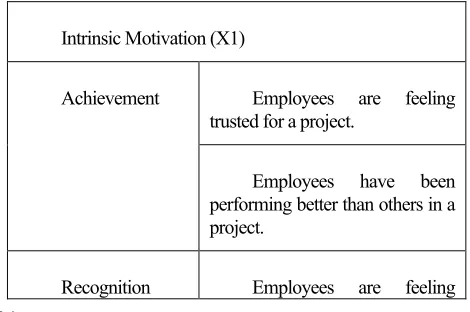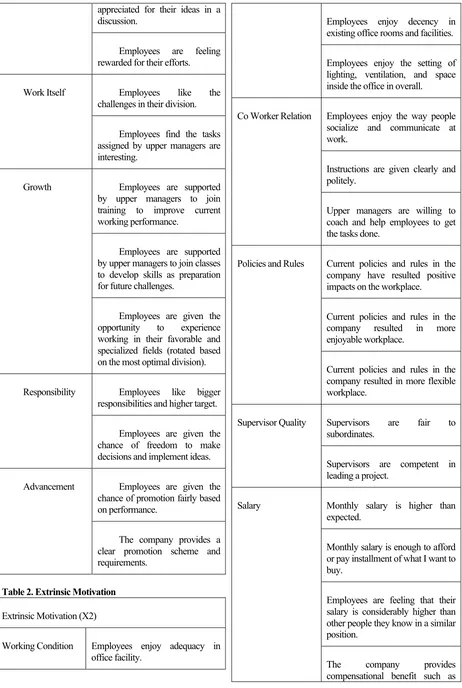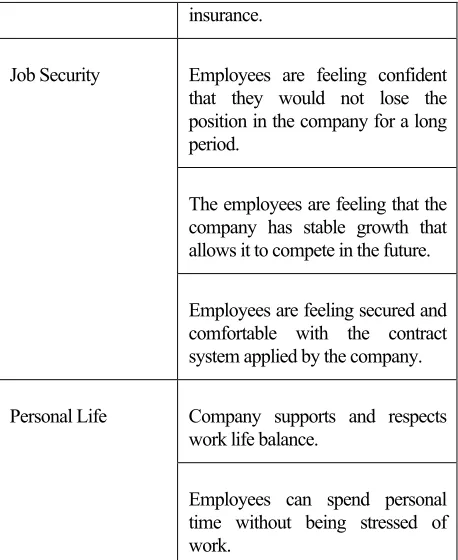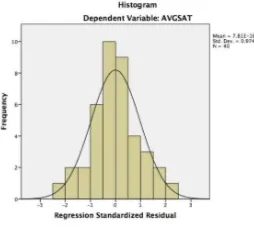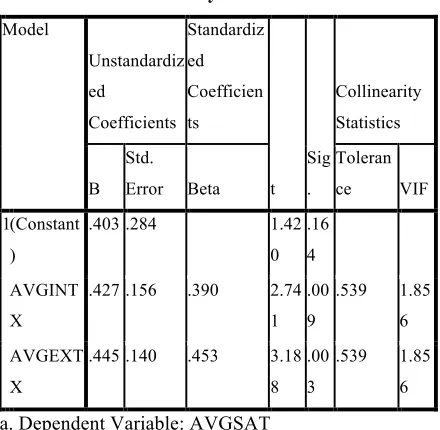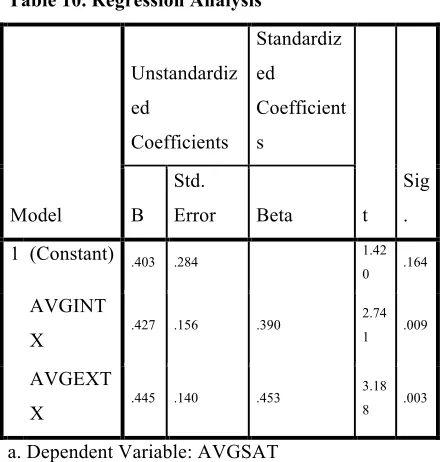331
Effect of Extrinsic and Intrinsic Motivation Factors to Employee Job Satisfaction
in PT Nutrifood Indonesia in Surabaya
Kevin Ray Charano, Steven Harijanto
International Business Management Program, Petra Christian University Jl. Siwalankerto 121-131, Surabaya
E-mail: [email protected], [email protected]
ABSTRACT
This study is accomplished to reveal what motivation factors affect employee job satisfaction in PT. Nutrifood Indonesia in Surabaya. Job satisfaction is an important factor that would determine employee performance and loyalty in the company. However, the researchers found out that there were many complaints from the employees in PT. Nutrifood Indonesia. Other than verbal confessions from the employees, low level of job satisfaction in the company might be revealed from the fact that the company suffered from a rather high employee turnover.
At first, this research would measure through questionnaire spread to 40 employees in PT Nutrifood Indonesia to find out whether the employees are satisfied with the job or not, plus what intrinsic and extrinsic motivation factors that affect the job satisfaction itself. For the analysis, the researchers use multiple regression analysis since the analysis will involve two independent variables, affecting single dependent variable.
The result of this research is showing that both extrinsic and intrinsic motivation factors significantly affecting employees’ job satisfaction in PT Nutrifood Indonesia in Surabaya
Keywords: Working motivation, job satisfaction, human resource development
ABSTRAK
Studi ini dilakukan untuk mengetahui faktor motivasi yang mempengaruhi kepuasan kerja karyawan di PT. Nutrifood Indonesia di Surabaya. Kepuasan kerja karyawan merupakan faktor penting yang menentukan performa dan loyalitas karyawan di perusahaan. Namun, peneliti menemukan cukup banyak complain dari karyawan PT. Nutrifood Indonesia. Selain daripada pengakuan secara verbal dari karyawan, taraf kepuasan karyawan yang rendah dapat ditengarai dari cukup tingginya taraf perputaran karyawan di perusahaan.
Pada mulanya, penelitian ini mengukur mealalui kuesioner yang dibagikan kepada 40 karyawan PT. Nutrifood Indonesia untuk mengetahui apakah karyawan disana puas atau tidak puas dengan kerja yang mereka jalankan, serta mengetahui faktor motivasi intrinsik dan ekstrinsik yang mempengaruhi kepuasan kerja itu sendiri. Untuk analisa, peneliti menggunakan analisa regresi berganda karena analisa yang dilakukan melibatkan dua variabel independen yang memperngaruhi satu variabel dependen. Hasil yang didapat dari penelitian ini menunjukkan adanya pengaruh yang signifikan baik dari faktor motivasi intrinsic maupun ekstrinsik terhadap kepuasan kerja karyawan di PT Nutrifood Indonesia di Surabaya
Kata Kunci: Motivasi kerja, kepuasan kerja karyawan, manajemen sumber daya manusia
INTRODUCTION
Job satisfaction of the employee is one important aspect that determines the success of one company (Ololube, 2004). Ross (2001) stated that job satisfaction is an attitude that employees have about their work and is based on numerous factors, both intrinsic and extrinsic to the individual. Job satisfaction is important from the perspective of maintaining and retaining the appropriate employees within the organization.
332 Figure 1. Response towards Job
Dissatisfaction
Source: Farrel and Rusbult (1992)
Herzberg (1959) argued that it’s a need to enlarging and enriching jobs to make them more meaningful and reduce the rate at which employees leave their jobs. In addition to that, Turner and Lawrence (1965), Hackman and Lawler (1971), and Hackman and Oldham (1975) also stated about a relationship between job dimensions, motivation and personal outcomes. The aforementioned outcomes were found to be influenced by interaction between psychological needs of the employee and the job. To put it simply, there is a relationship between motivation and satisfaction of the employees.
Based on Ryan and Deci (2000), intrinsic motivation is engaging in an activity because it is enjoyable and satisfying to do and is based on instinctive needs for competence and self-determination. Meanwhile, extrinsic motivation refers to the performance of an activity to attain some distinguishable outcome in which the action is based on the intention to achieve some instrumental aim such as earning rewards or avoiding penalties or punishments.
As explained in earlier section, job satisfaction is very much affected by intrinsic motivations and extrinsic motivations. It Shows that intrinsic and extrinsic motivation is the root determinants of how employee would be satisfied or dissatisfied with their job. Although research supports about correlation between job satisfaction and job performance has been hard to obtain for years, job satisfaction is desirable for a company.
In Figure 1. by Farrel and Rusbult (1992) it can be seen that employees can act in 4 behaviors, when they are dissatisfied with their job. In general, people who are dissatisfied with their job act in constructive or destructive way. When their actions are considered constructive, it only results in minor loss or even none of loss at all. However, they can also respond by resigning from the company without giving any feedback. In Figure 1.2, this situation is pictured in exit and neglect, which causes high employee turnover. This employee turnover is an indication of job satisfaction in the company. Thus, when a company suffers from high rate of employee turnover, it should understand that there is a possibility that their employees are dissatisfied with their job. Therefore, the company should try to find the external and internal causes that might result that dissatisfaction.
Another statement by Armstrong (2001) indicated that long-term employees generally have higher productivity
and efficiency on the job than newer employees, due to their length of experience with the firm, thus it is a need to maintain them to perform well in the company, and one way to maintain them is to maintain their satisfaction level. It shows that seniority gap among employees like mentioned are generally not desirable. And to correlate one major effect of lack in satisfaction, the researcher agree that opinion, saying organizations with low employee satisfaction levels tend to possess higher turnover rates than those with high satisfaction levels (Wright & Bonett, 1992). Thus, understanding intrinsic motivations and extrinsic motivations of employees is important, because it determines employee job satisfaction.
Job satisfaction of employee and adequate understanding about both intrinsic and extrinsic motivations by managers hold an important role in the company. Failure in understanding the issue could lead to job dissatisfactions that can create many problems and burdens for the company.
LITERATURE REVIEW
Motivation
Motivation is often interrelated with an underlying reason of why someone act and behave. In a workplace, motivation is important because it correlates with satisfaction of people in that particular organization. Based on general definition by Merriam-Webster (2003), motivation in a more specific definition related to working life or professional field is the condition of being eager to act or work. When referring to the definition by Merriam-Webster as it is in working life or professional field, a finding by Herzberg (1959) stated that motivation can be divided into two factors affecting job satisfaction; intrinsic motivation and extrinsic motivation. This theory about motivation by Herzberg (1959) was developed into a conclusion that those factors of motivation also have effects on performance, turnover, attitude towards company, and mental health of employees.
Intrinsic Motivation Factor
Intrinsic motivation is the purpose of doing something or an activity based on inherent satisfactions, not based on separable consequences that may result from that activity (Ryan & Deci, 2000). Referring to Baylor (2010) who adapted from Herzberg’s (1966) theory, intrinsic motivation is described as motivating factors that are centered on achievement, recognition, responsibility, advancement, growth, and the work itself.
In this research, the researchers want to define intrinsic motivation as employee motivation coming from inside (intra-personal) or passion of each person that might affect job satisfaction, which include these factors; achievement, recognition, responsibility, advancement, growth, and the work itself.
333 Recognition is a signal from supervisors towards employees’ effort that they are valued for their success in completing a task and their contribution in a project (Richardson, 2003).
Responsibility is about how to control over one’s work or that of others (Herzberg, 1966). Higher authority follows this responsibility as well.
Advancement is related to the positions of employees in the company. Job advancement shows the possibility of job promotion showing acknowledgement of employee performance.
Growth is associated with mobility, developmental opportunities, or acquisition of skills (Carmeli, Shalom, & Weisberg, 2007). Mobility is possibility for employees to work in other divisions (horizontal mobility) and other ranks or positions (vertical mobility). Meanwhile, skills are mended by training and development opportunity. While training is more focused on short-term basis, development is more focused on long-term basis.
Work itself is highly associated with employee attitudes towards the nature of the job itself (field of job and division) and how employees find it interesting and challenging. To some extent, the work itself concerns about job requirements and assigned tasks (Freed, 2003).
Extrinsic Motivation Factor
Extrinsic motivation is the purpose of doing something or an activity based on the separable outcome that may result from doing that particular activity, Ryan and (Deci, 2000). Baylor (2010) describes extrinsic motivation as motivating factors centered on supervision, working conditions, co-workers, policies and rules, pay, job security, and personal life. Baylor adopted these factors from hygiene factor of Herzberg (1966) Dual Factors Theory.
In this research, the researchers want to define extrinsic motivation as motivation, which is based on environment in the workplace coming from working conditions, co-workers, policies and rules, supervision, pay, job security, and personal life. The researchers stated most of the definitions below by using definitions in Herzberg’s (1966) study. Only some of them simple enough to understand are explained in brief explanation by the researchers, as the definitions are mostly similar in various sources.
Working conditions is described as physical work atmosphere inside and surrounding the workplace, including space, lighting, ventilation, and equipment (Herzberg, 1966).
It is interpersonal relationship among co-workers; coaching, helping with assignments, and giving instruction (Herzberg, 1966). A positive relationship has been found to contribute to motivation and mediate against stress (Shirey, 2004).
Policies and rules is about employee perceptions about how communications, practices, and benefits are managed in overall.
Supervision is employees’ general attitude towards their supervisors, related to their quality and competence (Herzberg, 1966). A positive supervisor-employee relationship influences the quality of two-way
communication, trust, and performance while increasing job satisfaction, organizational commitment, and lower intentions to quit (Harris, Harris & Eplion, 2007).
The term ‘Pay’ itself can be defined from general knowledge, thus the researchers define ‘Pay’ as a part of sources of income - incentive including monthly base salary and bonuses. While its definition is rather simple, measurement of this aspect is subjective. Furnham (2006) wrote that measurement of salary depends on each employee’s expectation. D’Ambrosio and Frick (2006) made a research leading to a conclusion that people measure their income satisfaction based on their perceived well-being from well-being richer than others (capability to afford stuffs easier than other people that they know), not based on how their basic needs are fulfilled. Thus, measurement of happiness about this aspect must be measured based on employee’s expectation and how they are feeling about their pay compared to others.
Job security is related to what extent the company willingly keeps the employees are permanent workers for long time period of time. Simply, this factor is shown by job stability or tenure (Herzberg, 1966). Ito and Brotheridge (2007) wrote that job security is related to advancement opportunity in the company. Organizational instability and ongoing change with potentially negative consequences undermine job security (Cooper, 2006). Therefore, the stability of the company itself is one important factor that determines whether an employee is feeling secured with his or her job or not.
Personal life explains about how an employee’s job affects his/her personal situation outside work (Herzberg, 1966).
Figure 2. Research Model
Locke and Lathan (1976) described job satisfaction as positive emotion felt by employees from their job, whether it is related to appraisal or experiences in the work fields. Job satisfaction is the result from how people in a particular workplace perceive how the job provides adequacy of important things in their life. Beginning from 1990s, researchers had understood the importance of job satisfaction in the workplace. This fact is shown by Mitchell and Lasan (1987), that organizational behavior and job satisfaction is the most important and frequently studied subject at the time. Even from years before, Herzberg (1959) had stated that job satisfaction is important for management of the company to pursue, because job satisfaction is related to employee performance or
Job Satisfaction Intrinsic
Motivation Factor
Extrinsic Motivation
334 productivity improvement sought in a particular company (although many other studies might contradict to this statement). In addition, considering it is such a subjective matter to begin with, Freeman (1978) also provides a standard measurement items to quantitatively measure job satisfaction such likability of the job, satisfaction of the job, and how enjoyable of the job is.
Understanding that job satisfaction is important, managers must suppress the level of employee dissatisfaction in their company as it might result in undesirable results. A theory by Farrel and Rusbult (1992) about response of people towards job dissatisfaction leads to a conclusion that high levels of job satisfaction supported constructive tendencies (voice and loyalty) and reduced destructive tendencies (exit and neglect), superior job alternatives supported active tendencies (exit and voice), and employee investment promoted constructive tendencies (voice and loyalty). Here, voice means that the employees are willing to actively share their satisfaction or dissatisfaction in the company for reasons, while neglect has an opposite meaning to voice. Loyalty means the employees are willing to stay committed to work in the company for a rather longer period, while exit means that the employees are willing to leave the company soon.
In this research, the researchers want to define employee’s satisfaction as feeling of being fulfilled coming from the fulfillment of extrinsic and intrinsic motivational factors of each employee. The measurement of job satisfaction can be simply obtained by likability of the job, satisfaction of the job, and enjoyability of the job.
Relations between Concepts
The researchers explain the relationship between intrinsic and extrinsic motivation and job satisfaction by adapting the model, which was used by Baylor (2010). This model about the relationship between motivation and job satisfaction is pictured on Figure 2. The research by Baylor (2010) is mainly inspired by dual factors theory of Herzberg (1959) also Porter and Lawler (1968) model of intrinsic and extrinsic motivation to increase job satisfaction. Referring to Baylor’s research, the researchers also attempt to investigate similar relationships in PT Nutrifood Indonesia.
The researchers then will examine the direct relationships of all related variables. The relationship between intrinsic motivation factors as well as extrinsic motivation factors and the level of job satisfaction is explained by understanding Baylor (2010) research about direct correlation of motivation and satisfaction, arguing that employees must have a perceived effort-reward probability, meaning that they have to be able to picture the goal in form of rewards (both intrinsic rewards and extrinsic rewards) as motivational factors. Basically they proposed making the job bigger and interesting as the intrinsic reward, and if the employees are able to perform better to keep up with the job, the wages and advancement opportunity will surely follow, and this could be interpreted as extrinsic rewards. By then, employees could generate efforts to then could be translated to their performance to reach the aforementioned rewards. Thus, the job satisfaction would increase as
working motivation increases. Proofs from previous researches by Locke and Latham (1990), Porter and Lawler (1968), and Machado (2011) explained the relation between motivation and job satisfaction.
There are several hypotheses which the researchers intend to examine in this research which are as following:
H1: Intrinsic motivation factors and extrinsic motivation factors simultaneously influence employees’ job satisfaction in PT Nutrifood Indonesia
H2: Intrinsic motivation factor has significant influence on employees’ job satisfaction in PT Nutrifood Indonesia H3: Extrinsic motivation factor has significant influence on employees’ job satisfaction in PT Nutrifood Indonesia
RESEARCH METHOD
Taking a look at the research methods proposed by Cooper and Schindler (2014) the researchers would like to use the causal research. This causal method is used more to find out the relationship between variables. The concept of this method is grounded in the logic of hypothesis testing, which in turn, produces inductive conclusions. Simply, it is investigating whether a change in certain variable causes a change in other variable.
In the research, the researchers would like to know how intrinsic and extrinsic motivation factors (X variables) will affect employee job satisfaction in PT Nutrifood Indonesia in Surabaya (Y variable) and which one of these intrinsic and extrinsic motivations affect the job satisfaction the most.
The independent variables in this research are divided into two; intrinsic motivation and extrinsic motivation. These variables explain what factors that mostly effective to motivate employees in PT Nutrifood Indonesia. As explained in the previous part in this research paper, motivation factors include intrinsic and extrinsic motivations. Hereby, those variables are described in more detailed description by using a relevant reference from Adair (1996) about effective motivation factors. Table 1 and 2 below explain both intrinsic and extrinsic motivation in sub-factors. Each sub-factor is expanded in sentences of how the questionnaire about these independent variables should be made.
Table 1. Intrinsic Motivation
Intrinsic Motivation (X1)
Achievement Employees are feeling trusted for a project.
Employees have been performing better than others in a project.
335 appreciated for their ideas in a discussion.
Employees are feeling rewarded for their efforts.
Work Itself Employees like the
challenges in their division.
Employees find the tasks assigned by upper managers are interesting.
Growth Employees are supported
by upper managers to join training to improve current working performance.
Employees are supported by upper managers to join classes to develop skills as preparation for future challenges.
Employees are given the opportunity to experience working in their favorable and specialized fields (rotated based on the most optimal division).
Responsibility Employees like bigger responsibilities and higher target.
Employees are given the chance of freedom to make decisions and implement ideas.
Advancement Employees are given the chance of promotion fairly based on performance.
The company provides a clear promotion scheme and requirements.
Table 2. Extrinsic Motivation
Extrinsic Motivation (X2)
Working Condition Employees enjoy adequacy in office facility.
Employees enjoy decency in existing office rooms and facilities.
Employees enjoy the setting of lighting, ventilation, and space inside the office in overall.
Co Worker Relation Employees enjoy the way people socialize and communicate at work.
Instructions are given clearly and politely.
Upper managers are willing to coach and help employees to get the tasks done.
Policies and Rules Current policies and rules in the company have resulted positive impacts on the workplace.
Current policies and rules in the company resulted in more enjoyable workplace.
Current policies and rules in the company resulted in more flexible workplace.
Supervisor Quality Supervisors are fair to subordinates.
Supervisors are competent in leading a project.
Salary Monthly salary is higher than expected.
Monthly salary is enough to afford or pay installment of what I want to buy.
Employees are feeling that their salary is considerably higher than other people they know in a similar position.
336 insurance.
Job Security Employees are feeling confident that they would not lose the position in the company for a long period.
The employees are feeling that the company has stable growth that allows it to compete in the future.
Employees are feeling secured and comfortable with the contract system applied by the company.
Personal Life Company supports and respects work life balance.
Employees can spend personal time without being stressed of work.
All those variables will be measured using the 5 points Likert scale ranging from 1 (Strongly Disagree) to 5 (Strongly Agree).
Job satisfaction in PT Nutrifood Indonesia is considered as a dependent variable in this research. Job satisfaction itself does not consist many sub-factors or complicated details. In practice, measurement of job satisfaction in PT Nutrifood Indonesia is divided into certain points; likability of the job, satisfaction of the job, and enjoyability of the job, Freeman (1978).
Table 3. Job Satisfaction
Job Satisfaction (Y)
In overall, employee likes working at PT Nutrifood Indonesia.
In overall, employee is satisfied working at PT Nutrifood Indonesia
In overall, employee enjoys working at PT Nutrifood Indonesia.
This dependent variable will be measured using the 5 points Likert scale ranging from 1 (Strongly Disagree) to 5 (Strongly Agree).
RESULTS AND DISCUSSION
The data will be gathered through primary data only. The data will be collected through distributing questionnaires, specifically to people who are still active as employees in PT Nutrifood Indonesia in Surabaya. This study was conducted by gathering sample of 40 people with any genders with working duration more than 3 months. The reason of why only include those people who have worked for more than three months is because the researchers would like to conduct the analysis by using the questionnaire result of permanent employees and eliminate the result of questionnaires filled by those people who have not yet experienced the working life in PT Nutrifood Indonesia as permanent employees. Moreover, the company usually uses contract system for the employment of new trainees. The duration of first trial or training contracts are mostly limited to three month period, which means those people who have passed the 3 month trial period can be considered as permanent employees who are eligible to fill in questionnaires. Employees include managers, assistant managers, staffs, administrations, and permanent public relations or brand ambassadors.
This study was conducted by gathering a target population of management (office) employees in PT Nutrifood Indonesia in Surabaya, consisting of 40 people, meaning the researchers do not include sales promotion person, field salesperson, and other employees located outside Surabaya and those who are placed in distributor offices. The next step would be to determine whether sample or census is used. Sample examines a portion of the target population, whereas census require researchers to examine all element of target population. In this case the researcher choose to use census, and examine all of the 40 management people of PT Nutrifood Indonesia in Surabaya. The questionnaires were spread in the office of PT Nutrifood Indonesia directly through printed questionnaire papers. This study clarifies the respondents by asking whether they have worked in the company for more than 3 months or less by using yes and no questions on the screening before rating the scales. The reason behind this screening question about duration of work is to understand that the employees who fill in the questionnaires have ever experienced working in the company as permanent employees for more than three months (not intern students or part-time employees).
This research will utilize data, processed using SPSS 22.0 for iOS X, and the researchers use multiple regression analysis since the analysis will involve two independent variables, hypothesized to explain the changes of a single dependent variable. In conduct the research, the researchers use the renowned method called Ordinary Least Squares (OLS) by Carl Friedrich Gauss to fulfill the classic best linear unbiased estimator (BLUE) assumption result. Validity and Reliability Test
Table 4. Result of Reliability Test
337 Intrinsic Motivation Factor 0.898 13
Employee’s job Satisfaction 0.841 3
Based on SPSS research conducted by the researchers, the Cronbach Alpha for all independent are higher than 0.7, which means the data are reliable to be researched further. The results are as following: extrinsic motivation (0.897), intrinsic motivation (0.954), and Employee satisfaction (0.841). For Validity test, researchers will use corrected item-total correlation value to check the validity of the dat. Based on R-value on R-table, the value of 40 samples is 0.312, whereas all items below for independent and dependent variables are already above 0.312, this means the data is valid to be processed further. Table 5. Result of Validity Test
Items (Intrinsic Motivation)
Corrected Item Total Correlation
ACH1 .643
ACH2 .656
REC1 .583
REC2 .667
WOI1 .677
WOI2 .438
GRO1 .367
GRO2 .577
GRO3 .559
RES1 .542
RES2 .645
ADV1 .751
ADV2 .702
Items(extrinsic Motivation)
Corrected Item Total Correlation
WOC1 .765
WOC2 .734
WOC3 .725
COW1 .718
COW2 .635
COW3 .587
POR1 .667
POR2 .741
POR3 .611
SUP1 .622
SUP2 .587
SAL1 .721
SAL2 .665
SAL3 .831
SAL4 .744
JOB1 .626
JOB2 .768
JOB3 .813
PER1 .714
PER2 .726
Items( Satisfaction) Corrected Item Total
Correlation
SAT1 .682
SAT2 .668
SAT3 .768
BLUE Classic Assumption Tests
There are four classical assumption tests to be performed for four linearregression models as the preliminary steps.
Normality
Normality test is a test to show that the data are normally distributed, and as shown on the graph, the data is normally distributed.
Figure 3. Normality Graphical Test
Aside from graphical test that could lead to misleading the researchers also conduct statistical test using Kolmogorov-Smirnoff test. From the test, the researchers found out that the value of Asymp. Sig. (2 Tailed) of the independent variables (AVGINT and AVGEXT) and the dependent variable (AVGSAT) are more than 0.05. Thus it is considered that the test distribution is normal.
Table 6. Kolmogorov – Smirnof Test
AVGINT X
AVGEXT X
AVGSA T
N 40 40 40
Normal Parametersa,
b
Mean 2.30385 2.25500 2.39167 Std.
Deviatio n
.691749 .771346 .758194
Most Extreme Differences
Absolute .145 .176 .133 Positive .145 .176 .133 Negative -.105 -.145 -.083
Kolmogorov-Smirnov Z
.916 1.113 .844
338 Autocorrelation
To check whether there are any correlations between residuals, the researchers utilize the Durbin-Watson test. Based on Durbin-Watson table for 0.05 confidence level regression, using 2 independent variables and 40 samples, the du is 1.600 and dl is 1.391. For the data to be free of autocorrelation then the Durbin-Watson should follow the criteria which is du < d < 4 – dl. In this research, the Durbin-Watson should be higher than 1.600 and lower than 2.4. The result in table 4.7 shows the Durbin Watson is 2.027, which means the data is free from autocorrelation.
Multicollinearity
Multicollinearity could be checked by looking at the value in VIF and the tolerance. The tolerance should be higher than 0.1 and the VIF should be lower than 10. The result from the data used by the researchers shows that there are no multicollinearity in the data used in this research, since the tolerance for both independent variable is higher than 0.1 and the VIF is lower than 10 (1.856 for both variables) as shown on table below.
Heteroscedasticity Test
To check whether there are differences in variance among residual, the researchers conduct the heteroscedasticity test by using scatterplot diagram and Park test. As shown below on scatterplot diagram, the residual are scattered randomly, with no trend detected.
Figure 4. Scatterplot
a. Dependent Variable: LNSQR
Park test is also used to determine whether the data is having heteroscedasticity or not. This test shows the existence of heteroscedasticity if the
value of Beta in Standardized Coefficient is significant. Thus, there is no heteroscedasticity in the data since the value of Beta is not significant (above 0.05). Statistical Tests
After making sure the data is reliable and valid, researchers analyze the data using regression analysis. The independent variables are extrinsic motivation and intrinsic motivation factors, whereas the dependent variable is Employees’ Job Satisfaction in PT Nutrifood Indonesia in Surabaya. In this regression analysis, the adjusted R Square is 0.575. It means the variance in independent variable explain 57.5% of the change of variance in the dependent variable.
339 Using F Test, the researcher would like to know whether both independent variables simultaneously and significantly explaining the dependent variable. As shown on table below, since the F value is higher than 4 with 0.000 significance level, which is below 0.05, then we could accept the HA that the independent variables simultaneously and significantly explaining the dependent variable.
Table 9. ANOVA Test
Model Sum of
Squares df Mean
Square F Sig. 1 Regression 13.385 2 6.693 27.411 .000a
Residual 9.034 37 .244 Total 22.419 39
a. Predictors: (Constant), AVGEXTX, AVGINTX b. Dependent Variable: AVGSAT
Y = 0.403 + 0.427 AVGINTX + 0.445 AVGEXTX + E Where Y = Predicted Value of “Employees’ Job Satisfaction in PT Nutrifood Indonesia in Surabaya”
Table 10. Regression Analysis
Model
Unstandardiz ed
Coefficients
Standardiz ed Coefficient s
t Sig . B
Std.
Error Beta
1 (Constant) .403 .284 1.42
0 .164
AVGINT X
.427 .156 .390 2.74
1 .009
AVGEXT X
.445 .140 .453 3.18
8 .003
a. Dependent Variable: AVGSAT
There are two independent variables that included in the model to determine the significant influence towards dependent variable, which are extrinsic and intrinsic motivation factor. Moreover, these independent variables also determine whether null hypotheses are accepted or rejected.
The first independent variable is intrinsic motivation factor (AVGINT). T-test on the upper table shows that the value of Sig. 0.009, which is lower than 0.05. Thus, the researchers may conclude the first X variable is significant to explain the Y variable.
The second independent variable is extrinsic motivation factor (AVGEXT). From the t-test, the researchers got the value of 0.003, which is considered as significant to individually explain the result of the Y variable.
In conclusion, each of independent variables individually is significant to explain the dependent variable. Thus, intrinsic motivation factor (AVGINTX) results in B value of 0.427 and extrinsic motivation factor (AVGEXTX) results in B value of 0.445; Y = 0.403 + 0.427 AVGINTX + 0.445 AVGEXTX + E.
From the beginning, the researchers used Baylor’s (2010) research as a basis of the research in PT. Nutrifood Indonesia in Surabaya. Baylor (2010) used the theory of Herzberg (1959) to construct two independent variables that the researchers also used in this research; extrinsic variable and intrinsic variable. Those independent variables are then used as a determinant of job satisfaction in PT Nutrifood Indonesia, which is taken as a single dependent variable in the research.
From the very beginning, this research was conducted based on a perspective that PT. Nutrifood Indonesia might have moderate to low job satisfaction shown by employee turnover rate in the company. This presumption of how job satisfaction and employee turnover are correlated to each other is shown by Baylor’s (2010) research model explaining that there was correlation between job satisfaction and intention to quit from the company. In the same model, Baylor (2010) also explained that the root of job satisfaction itself consists of two motivational factors or two independent variables.
Baylor’s research is proven true in this research as the researchers got the result from t test that each of the independent variables (extrinsic variable and intrinsic variable) is significant to explain the dependent variable (job satisfaction).
A research (Freeman,1978) was a basis of our research to measure job satisfaction in PT. Nutrifood Indonesia. Freeman (1978) used likability, satisfaction, and enjoyability of their job based on subjective perception to measure job satisfaction. In this research, data of job satisfaction can be considered as reliable as the value of Cronbach’s Alpha is 0.840, which is higher than 0.700. Thus, by using subjective measurement of likability, satisfaction, and enjoyability of the job, the researchers obtained precise and accurate data of job satisfaction in PT. Nutrifood Indonesia in Surabaya. Moreover, validity test shows that corrected item-total correlation for each question scores higher than 0.304. It shows that all those questions, including questions to measure job satisfaction, are measuring what the researchers are really willing to measure.
CONCLUSION
340 level. In this research, the researchers attempt to analyze the relation of extrinsic and intrinsic motivation factors towards the employees’ satisfaction level.
Based on the result of this research, it’s obvious that both extrinsic and intrinsic motivation factors are important and significant determinants for employee’s satisfaction level there. In addition, the extrinsic motivation factors are slightly more significant in determining employees’ satisfaction level in this company, thus, the researchers already able to answer the research problem and objectives.
This research could also be considered as one reference as to how PT Nutrifood Indonesia in Surabaya should manage their employees, especially in managerial level, by tapping into their sources of motivation. The company could formulate more effective strategies which may improve employees’ satisfaction level while working there. This research also gives benefits for the researchers, in a way that the researchers could apply their knowledge on conducting proper research, and delivering ideas while developing analytical and conceptual skills learned so far.
REFERENCES
Ololube, N. P. (2004). Teachers Job Satisfaction and Motivation for School Effectiveness: An Assessment.
Cooper, R. D., & Schindler, S. P. (2014). Business Research Methods. Singapore: Mc Graw-Hill.
Allison, P. (2012, September 10). When Can You Safely Ignore Multicollinearity? Diambil kembali dari Statistical Horizon Web Site: http://www.statisticalhorizons.com/multico llinearity
Monro, B. (2000). Statistical Methods for Health Care Research. Philadelphia: Lippincott. Normality Test. (t.thn.). Diambil kembali dari
originlab:
http://www.originlab.com/doc/Origin-Help/Normality-Test
Assumption of Linearity. (t.thn.). Diambil kembali dari utexas.edu:
http://www.utexas.edu/courses/schwab/sw3 88r7/Tutorials/RegressionAssumptionsand DiagnosticStats_doc_html/004_Assumptio n_of_Linearity.html
Regression Analysis:Homoscedasticity. (t.thn.). Diambil kembali dari Statistic Solution: http://www.statisticssolutions.com/homosc edasticity/
Laerd Statistic. (2014). Diambil kembali dari Laerd Statistic: https://statistics.laerd.com/spss-
tutorials/img/lr/heteroscedastic-relationships.png
Nunnaly, & Bernstein. (1994). Psychometric Theory. New York: McGraw-Hill.
Ghozali, I. (2011). Aplikasi analisis multivariate dengan program IBM SPSS 21 (7th ed.). Semarang, Jawa Tengah, Indonesia: Badan Penerbit Universitas Diponegoro.
Baylor, K. M. (2010). FOR OCCUPATIONS CHARACTERIZED BY HIGH VOLUNTARY ATTRITION. UMI Publishing.
Hackman, J., & Oldham. (1975). The job diagnostic survey: An instrument for the diagnosis of jobs and the evaluation of job redesign projects. Department of Administrative Sciences: Yale University.
Argyris, C., & Donald, S. A. (1995). Organizational Learning II: Theory, Method, and Practice Ryan, R. M., & Deci, E. L. (2000). Intrinsic and
Extrinsic Motivations: Classic Definitions and New Directions.
Rusbult, C. E., & Farrell, D. (1992). Impact of Exchange Variables on Exit, Voice, Loyalty, and Neglect: An Integrative Model of Responses to Declining Job Satisfaction. Armstrong, M. (2001). Performance Management. Ito, J. K., & Brotheridge, C. M. (2007). Exploring the
predictors and consequences of job insecurity's components.
Adair, J. (1996). Effective Motivation.
Machado, M. d. (2011). 2.3.1 A Look to Academics Job Satisfaction and Motivation in
Portuguese Higher Education Institutions . Herzberg, F. (1959). The motivation to work. Wiley Carmeli, A., SHALOM, R., & Weisberg, J. (2007).
Considerations in organizational career advancement: what really matters. Wright, T. A., & Bonett, D. G. (1992). The effect of
turnover on work satisfaction and mental health: Support for a situational
perspective. Journal of Organisational Behaviour
Locke & G. P. Latham (Eds), A Theory of Goal Setting and Task Performance. Englewood Cliffs, NJ: PrenticeHall.
Furnham, A., (2006), Pouring Money Down the Drain?, The British Journal of
Administrative Management, Institute of Administrative Management, London Ross, J. A., Hogaboam-Gray, A., & Hannay, L.
(2001). Effects of teacher efficacy on computer skills and computer cognitions of K-3 students. Elementary School Journal Freeman, R. B. (1978) "Job Satisfaction As An
